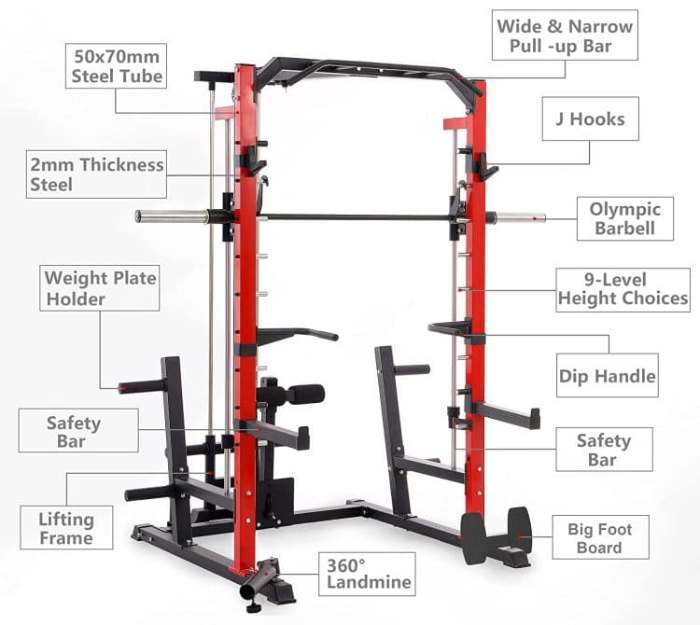Navigating a gym can feel like exploring a forest filled with different species of workout equipment. You’ve likely encountered the Smith Machine, a staple in many gyms. You might be curious about the weight of its bar.
On average, a Smith Machine bar weighs 15-20 lbs, lighter than a standard barbell. However, factors like the machine’s model and design can affect this. Understanding the weight of the Smith Machine bar can help you accurately calculate the total weight you’re lifting, which is essential in effectively tracking your progress.
So, let’s dive into the nitty-gritty details of the Smith Machine bar weight.
Contents
- 1 Understanding the Smith Machine: Functionality of Weightlifting Equipment
- 1.1 Anatomy of Smith Machine Bar: the Structure and Components of the Bar
- 1.2 Standard Smith Machine Bar Weight: Identifying the Typical Weight Associated with the Bar
- 1.3 Factors Affecting Bar Weight: Variables that May Influence the Load
- 1.4 Exploring How Smith Machine Bar Weight Shapes Exercise Regimens:
- 1.5 Frequently Asked Questions:
- 1.6 Conclusion:
Understanding the Smith Machine: Functionality of Weightlifting Equipment
First, you must understand that a Smith Machine is gym equipment designed for safe weightlifting. It’s a vital tool emphasizing machine safety, perfect for beginners and seasoned lifters.
The machine’s integrated safety mechanism restricts the barbell to a vertical pathway, preventing unnecessary movement that might cause injury. This setup lets you lift weights without needing a spotter, giving you an extra safety layer.
Now, let’s talk about equipment variations. Smith Machines come in various models, each with different weight capacities.
Standard ones typically start with a 15-20 pound unloaded barbell, while commercial-grade variations can have bars weighing up to 45 pounds. Understanding these differences helps you gauge the machine’s weight accurately.
Anatomy of Smith Machine Bar: the Structure and Components of the Bar
To understand the weight of a Smith Machine bar, you’ve got to grasp its anatomy. The bar’s construction and safety features significantly influence its weight.
The bar construction involves sturdy steel, designed for heavy lifting. Its linear structure allows vertical movement, making it distinct from free-weight barbells.

Safety features include hooks and safety stoppers. These allow you to re-rack the bar any time during your lift, minimizing the risk of injury.
Refer to the table below for a deeper understanding:
| Component | Material | Function |
|---|---|---|
| Bar | Steel | Provides structure for lifting |
| Hooks | Metal | Allow easy re-racking of the bar |
| Stoppers | Metal | Prevent the bar from falling |
Standard Smith Machine Bar Weight: Identifying the Typical Weight Associated with the Bar
You might be surprised to learn that the standard weight of a Smith Machine bar is usually around 15 to 20 pounds, unlike the traditional barbell that weighs 45 pounds.
This significant difference in weight is mainly because the Smith Machine bar is counterbalanced. This lets you focus on form and lift safely, even without a spotter.
When considering weight increments, you’ll find that adding weight to a Smith Machine bar is a straightforward process. You can easily increase the load in small amounts, which is ideal for gradual strength progression.
Lastly, let’s talk about bar maintenance. It’s vital to regularly inspect and clean your bar to ensure it stays in top condition. Proper maintenance not only prolongs the life of your bar but also ensures safer workouts.
Factors Affecting Bar Weight: Variables that May Influence the Load
While the standard weight of a Smith Machine bar is around 15 to 20 pounds, various factors can affect this weight. One of these is barbell variations.
Different models of the Smith Machine may have different bar weights, some lighter, some heavier, designed to fit various workout needs. Another factor is weight accuracy. The actual weight of the bar can sometimes differ from the stated weight due to manufacturing tolerances.
Here’s a table to illustrate:
| Factor | Effect | Example |
|---|---|---|
| Barbell Variations | Different models have different weights | Smith Machine A vs B |
| Weight Accuracy | Actual weight may differ from stated weight | Manufacturer’s tolerance |
| Maintenance | Poor maintenance might alter the weight | Rust, wear and tear |
Understanding these factors will help you make a more informed choice when using a Smith Machine.
Exploring How Smith Machine Bar Weight Shapes Exercise Regimens:
In light of these bar weight variations, your Smith Machine workout routine can be significantly affected. Understanding the weight you’re lifting for routine optimization is essential.
If you’re under the impression that the bar weighs more than it does, you may not be pushing yourself as hard as you could be, stunting your progress.
Conversely, believing it’s lighter could lead to overexertion and potential injury. To avoid these pitfalls, consider equipment alternatives. Regular barbells, for instance, have a standard weight that can provide consistency.
If you stick with the Smith Machine, ensure you know the bar weight. This knowledge will empower you to accurately measure your strength gains and adjust your workout routine as necessary.
Frequently Asked Questions:
When using a Smith machine bar, always check for proper bar maintenance. It’s crucial to prevent injury. Use correct lifting techniques, adjust safety stops, and don’t overload the bar. Always warm up before starting.
It would be best to service your Smith machine bar annually for optimal maintenance and machine longevity. Regular check-ups ensure it’s safe and functioning, helping you get the most out of your workouts.
You’ll notice weight variations when comparing a Smith machine bar to a regular barbell. Typically, the Smith bar is lighter due to its durability design. It’s often counterbalanced, reducing its weight compared to standard barbells.
Yes, there’s a difference. Barbell variations engage more muscles due to stabilization needs, while Smith’s machine limitations result in less muscle engagement as the machine aids in controlling the weight’s path.
You can use the Smith machine for a variety of weightlifting exercises. Its versatility allows for many exercise variations. However, it doesn’t engage muscles as comprehensively as free weights due to its fixed movement path.
Conclusion:
So, you’ve learned that a standard Smith machine bar typically weighs around 15-20 pounds. But remember, factors like brand and design can make a difference. Don’t let this deter you.
Incorporate this knowledge into your workout routine to accurately gauge your strength and progress. After all, understanding your equipment is just as crucial as the workout itself.
Master this, and you’re heading to a more effective, better-informed fitness journey.

Santhan, known to many as Linda, combines her personal training expertise with exceptional motivational coaching skills. Her articles are not just informative but also incredibly inspiring, encouraging readers to take action and pursue their fitness goals. Linda’s unique approach to writing integrates practical fitness guidance with motivational elements, making her content both useful and uplifting.
